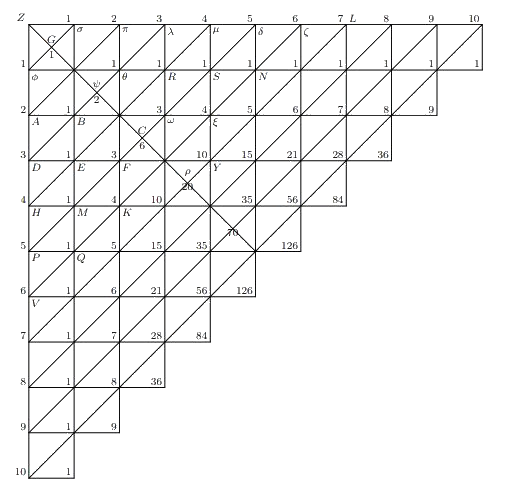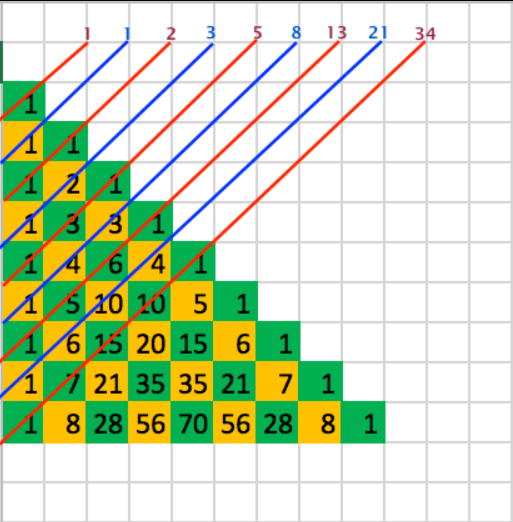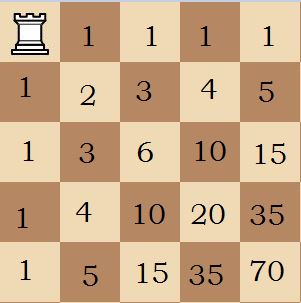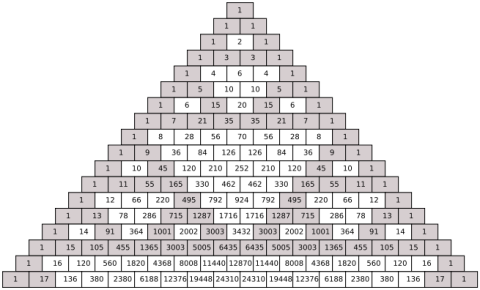The Arithmetic Triangle is one of the most simple yet beautiful constructions in mathematics. Frequently called as Pascal’s Triangle, the history of it dates back to centuries before Pascal’s work. Indian mathematicians like Pingala and Varāhamihira had ideas of generating binomial coefficients via the additive identity
\[\binom{n}{r}=\binom{n-1}{r}+\binom{n-1}{r-1}\]as well as the Jain mathematician Mahāvīra in his revamped, modern representation of binomial coefficients via factorials. It was also known independently in other parts of the world; called the Khayyam Triangle in Iran, Yang Hui’s Triangle in China (to this date) and Tartaglia’s Triangle in Italy. Nevertheless, in his treatise Traité du triangle arithmétique, Pascal gave a mathematical treatment like never before [1].

Figure 1. The Arithmetic Triangle as constructed by Pascal in his Traité du triangle arithmétique, 1665.
He presented us with 19 consequences/properties of the Arithmetic Triangle, as well as many lemmas and fields of usage of the same. These include the inclusion of chance based two player games that involve the transfer of money/shares [2]. He also talked about the its use in binomial expansions and combinatorics, ones which are more common to the general math student. However, ignorant would be the mathematician’s mind that refuses to go beyond this and explore the diverse, apparently unrelated corners of mathematics connected by this simple construction.
What is the worth of learning something that you can look up on the net? - Sohom Gupta.
We shall therefore delve into some of the lesser known ideas surrounding the Arithmetic Triangle. A bit of focus is all you need to realize the kaleidoscope of mathematics imbibed into this construct.
The Pascal Matrix
Mathematically formulating any pictorial dataset may not be trivial, but for Pascal’s Triangle, it is easier than expected. Pascal’s Matrix, to the author, is the best way to let us study it completely, to any general degree. So let’s define it quickly; note that there can be many versions of the matrix but we’ll look at the simplest one, the lower diagonal Pascal Matrix $L_n$:
\[L_n = \begin{pmatrix} 1 & & & & & &\\ 1 & 1 & & & & &\\ 1 & 2 & 1 & & & &\\ 1 & 3 & 3 & 1 & & &\\ . & . & . & . & . & & \\ . & . & . & . & . & . & \\ 1 & n & . & . & . & n& 1\\ \end{pmatrix}_{(n+1)\times (n+1)}\]where the blank spaces are all zeroes. This resembles an inclined plane, but the ride down it is bumpy with all the $1$’s pointing up! At least all rows of the matrix correspond to the rows of Pascal’s Triangle (except the zeroes, which got Thanos snapped). We have
\[(L_n)_{ij}=\begin{cases} \binom{i}{j} & i\geq j \\ 0 & j>i \end{cases},\]where counting of rows and columns start from zero (point to be noted!).
Eigenvalues and Eigenvectors
The lower Pascal Matrix $L_n$ has determinant $1$, as the determinant of a lower triangular matrix is just the product of its diagonal elements. Its eigenvalues are the solutions of
\[\text{det}(L_n-\lambda I_n)=(1-\lambda)^n=0\]which gives $\lambda = 1$ ($I_n$ is the $(n+1)\times (n+1)$ Identity matrix - did you get it?).
The diagonal elements all being $1$ makes $L_n$ a unitriangular matrix, and therefore unipotent [3], i.e, $L_n-I_n$ is nilpotent, having the null matrix as a higher power. (Non-mathematicians, don’t work yourself up. This is the jargon we deal with all day :/).
An eigenvector $v_n$ of $L_n$ would thus satisfy $L_nv_n=v_n$. Say we have
\[v_n= \begin{pmatrix} x_1\\ x_2\\ x_3\\ . \\ . \\ x_n\\ \end{pmatrix}_{n\times 1}\]A dedicated solution of the eigenvalue problem (which is just equating the elements of the left and right matrices) would set $x_1=x_2=\ldots=x_{n-1}=0$. This is an interesting property of unipotent triangular matrices like $L_n$ - the set of linearly independent eigenvectors has a single element.
Imagine a $40\times 40$ Hamiltonian that has only one eigenvector. It’s actually a treasure for Physics students tasked with calculating the Energy Eigenvalues and Eigenstates.
Higher Powers and Hypercubes [7]
Ok, that reference is cheeky; not that it matters.
Higher powers of the Pascal Matrix follow an interesting pattern. Note that, taking $i\geq j$
\[(L^2_n)_{ij}=\sum_{k=j}^i(L_n)_{ik}(L_n)_{kj}=\sum_{k=j}^i\binom{i}{k}\binom{k}{j}=\sum_{k=j}^i\binom{i}{j}\binom{i-j}{k-j}=\binom{i}{j}2^{i-j}\]In fact, we can generalize this easily to higher powers via induction (as opposed to deduction), arriving at
\[(L^k_n)_{ij}=k^{i-j}\binom{i}{j}\]for all $k$ among naturals [4], [5]. The particular case for $k=2$ is very interesting.
\[H_n = \begin{pmatrix} 1 & & & & & &\\ 2 & 1 & & & & &\\ 4 & 4 & 1 & & & &\\ 8 & 12 & 6 & 1 & & &\\ . & . & . & . & . & & \\ . & . & . & . & . & . & \\ 2^n & n2^{n-1} & . & . & . & 2n& 1\\ \end{pmatrix}_{(n+1)\times (n+1)}\]I call it $H_n$ as the $(i,j)$ entry in it is precisely the number of $j$ dimensional Hypercubes on the boundary of an $i$ dimensional Hypercube. Don’t know what a hypercube is? They are the family of polytopes given by (Point, Line Segment, Square, Cube, Tesseract, …), basically the $[0,1]^n$ subset of $\mathbb{R}^n$. Every hypercube has smaller hypercubes on its boundary, e.g. cubes have points, line segments and squares on its boundary, often referred to as vertices, edges and faces. Remember $V-E+F=2$ for a cube? Well, now you just need to check whether
\[(H_n)_{30}-(H_n)_{31}+(H_n)_{32}=2\]and it is! In fact, just by looking at the pattern of numbers in $H_n$, we can even extend Euler’s formula for the hypercube family to higher dimensions. Also note that while you’d get $2^r$ when summing the $r^{th}$ row of the Pascal Matrix, you’ll get $3^r$ for this Hypercube matrix. It is easy to see how higher powers behave.
Before moving on, do note that $L_n^k$ is always unipotent, i.e. has all eigenvalues equal to unity.
Recurrence Relations
Recurrence relations are relations that recur. By the way, there’s a way to retrieve Fibonacci numbers from the Pascal Matrix! Indeed, looking closely into the pattern in Figure 2 and formulating it via matrix definition gives us this popular equality
\[F_n=\sum_{r=0}^{\left\lfloor\frac{n}{2}\right\rfloor}\binom{n-r}{r}\]We describe the Fibonacci numbers as $F_0=0$, $F_1=1$, $F_n=F_{n-1}+F_{n-2}$ for $n\geq 2$. Did you know that the ratio $F_{n+1}:F_n$ tends to the Golden Ratio?
Life is full of surprises, ain’t it? Everytime you see it on your favourite flower, do make a prayer to the Arithmetic Triangle.
Such a discovery is exciting, but how about more? What if we apply the same diagonal addition on powers of $L_n$?

Figure 2. Diagonal summation to obtain Fibonacci numbers from Pascal’s Triangle. Image courtesy: Wikipedia/Pascal’s Triangle
You’d quickly see that the same process applied on $H_n$ will give us the sequence
\[1,2,5,12,29,70,169,\ldots\]Wait. This can be generalized by $G_0=0, G_1=1$, and
\[G_n=2G_{n-1}+G_{n-2}\]for $n\geq 2$! These are called Pell numbers, and they satisfy the equality
\[G_n=\sum_{r=0}^{\left\lfloor\frac{n}{2}\right\rfloor}2^{n-2r}\binom{n-r}{r}\]If you move further and calculate the diagonal sums of say, $L^k_n$, you’ll only come across terms of the sequence $a_0=0$, $a_1=1$ and $a_n=ka_{n-1}+a_{n-2}$. These are called Fibonacci k-sequences [6].
What can you say about the ratio $a_{n+1}:a_n$ as $n$ tends to infinity? May not be golden, but shall certainly glitter.
Other niceties
In chess, a rook moves either vertically or horizontally (exclusive OR). It can move from 1 square to as many squares as possible in either direction without leaving the board. But if one were to take a chessboard and find out the number of distinct paths a rook placed at a corner can take to another square (without any back-tracing), where to look but the Pascal’s Triangle!

Figure 3. Number on a square is the number of distinct paths the rook can take to reach there. Note that it coincides with Pascal’s construction of the Arithmetic Triangle. Image courtesy: MS Paint.
Pascal would be proud to see Figure 3. Source: trust me bro.
And not just in games, but also very weird and unique shapes in math - fractals! Odd/Even numbers form a very nice pattern on the Arithmetic Triangle. If we were to shade them in different colours on an Arithmetic Triangle extended to infinity, it would become a popular fractal known as Sierpinski Triangle, which has zero area but infinite perimeter. I don’t know what is more fascinating than this beauty of the beast.
Did you know that fractals are somewhat represented in real life as well, e.g. the coast of a continent/island as seen from outer space?? This means that if you zoom in, you’ll see a similar structure to what you initially saw - that is what self-similarity is all about. A math fractal can be zoomed in as much as possible and we shall always see a replication of the original one! Ever looked into the very vibrant Mandelbrot or Julia sets? Do it, the clock is ticking…

Figure 4. Shading of the Arithmetic Triangle where the even numbers are coloured white and the rest black. This closely resembles the self-similar fractal called Sierpinski Triangle.
Much more to see
While that is all I have to present now, it is not the end! There are many more recurrence relations popping out of the Triangle, the Pascal Matrix has other forms which provide us with more interesting results, it is also used to devise winning strategies in games of chance where you need to bet a share (as Pascal mentioned in his treatise). It can never be fulfilling enough for an inquisitive mind to end their venture with the end of this article. So take up your pen and paper, and wade through the countably infinite world of the Arithmetic Triangle!
References
- Wikipedia, Pascal’s Triangle
- Pascal, B., The Arithmetic Triangle
- Wolfram MathWorld, Unipotent
- Zhang, Z., The linear algebra of the generalized Pascal matrix, Linear Algebra and its Applications, 250, 51-60 (1997).
- Edelman A. and Strang G., Pascal matrices, American Mathematical Monthly, 111:3, 189-197 (2004)
- Falcon S., The k-Fibonacci matrix and the Pascal matrix, Open Mathematics, 9.6, 1403-1410 (2011).
- Gupta S., Theory on Dimensions, Int J Sci Res Publ, 7(11) (2017)